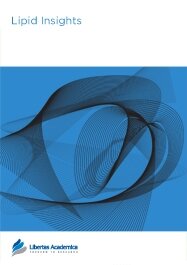

Publication Date: 08 Oct 2012
Type: Original Research
Journal: Lipid Insights
Citation: Lipid Insights 2012:5 19-34
doi: 10.4137/LPI.S10291

Atlantic cod is a coldwater teleost of commercial importance. The intestinal epithelium is a large organ in vertebrates serving an important role in nutrient selection and uptake as well as an immunological barrier. Here, we perform lipid and fatty acid analysis of the plasma membrane from the cod intestinal enterocytes after separation of the brush border membrane and the basolateral membrane fractions. Our results show that both membrane fractions contain an unusually high amount of cholesterol and glycolipids but low levels of glycerophospholipids compared with other reported studies on fish. Sphingomyelin was the dominant lipid in the brush border fraction and was also prominent in the basolateral fraction where phosphatidylcholine was the dominant glycerophospholipid. Furthermore, our results show a distinct difference in fatty acids content, where monounsaturated fatty acids (MUFA) were more abundant than polyunsaturated fatty acid (PUFA). Nervonic acid (24:1n-9) was a prominent fatty acid in the BBM at ~50% of the total MUFA. We hypothesize that the high cholesterol content and the presence of this rare fatty acid may serve to maintain membrane fluidity in the cold environment.
PDF (931.93 KB PDF FORMAT)
RIS citation (ENDNOTE, REFERENCE MANAGER, PROCITE, REFWORKS)
BibTex citation (BIBDESK, LATEX)

Working with the Editor at the Journal of Medical Education and Curricular Development, and the publishing staff at Libertas Academica was an excellent experience. From submission to revision, the editorial process was smooth and fair. I had such a good experience that I will consider journals of Libertas Academica at the top of my list the next time I want to submit a manuscript.
Facebook Google+ Twitter
Pinterest Tumblr YouTube